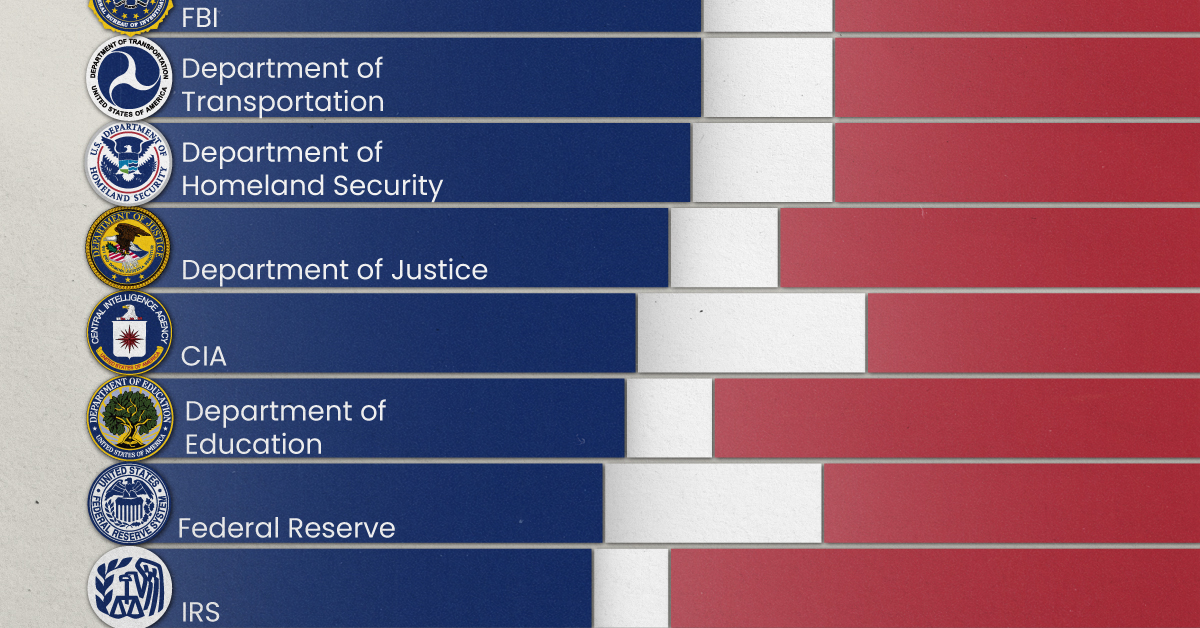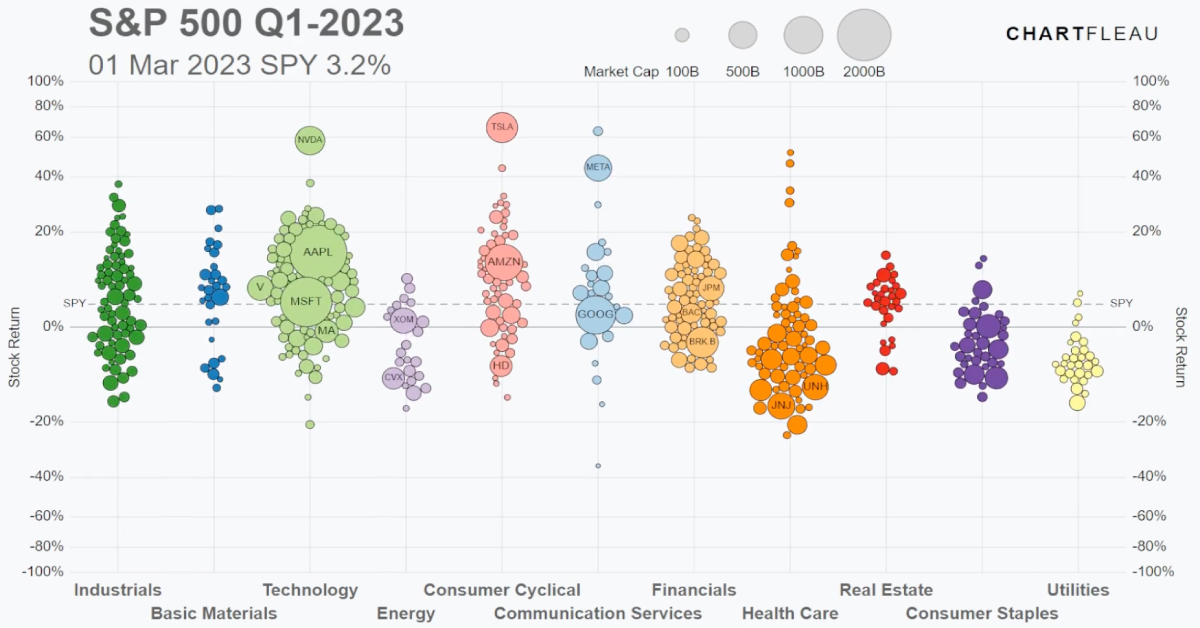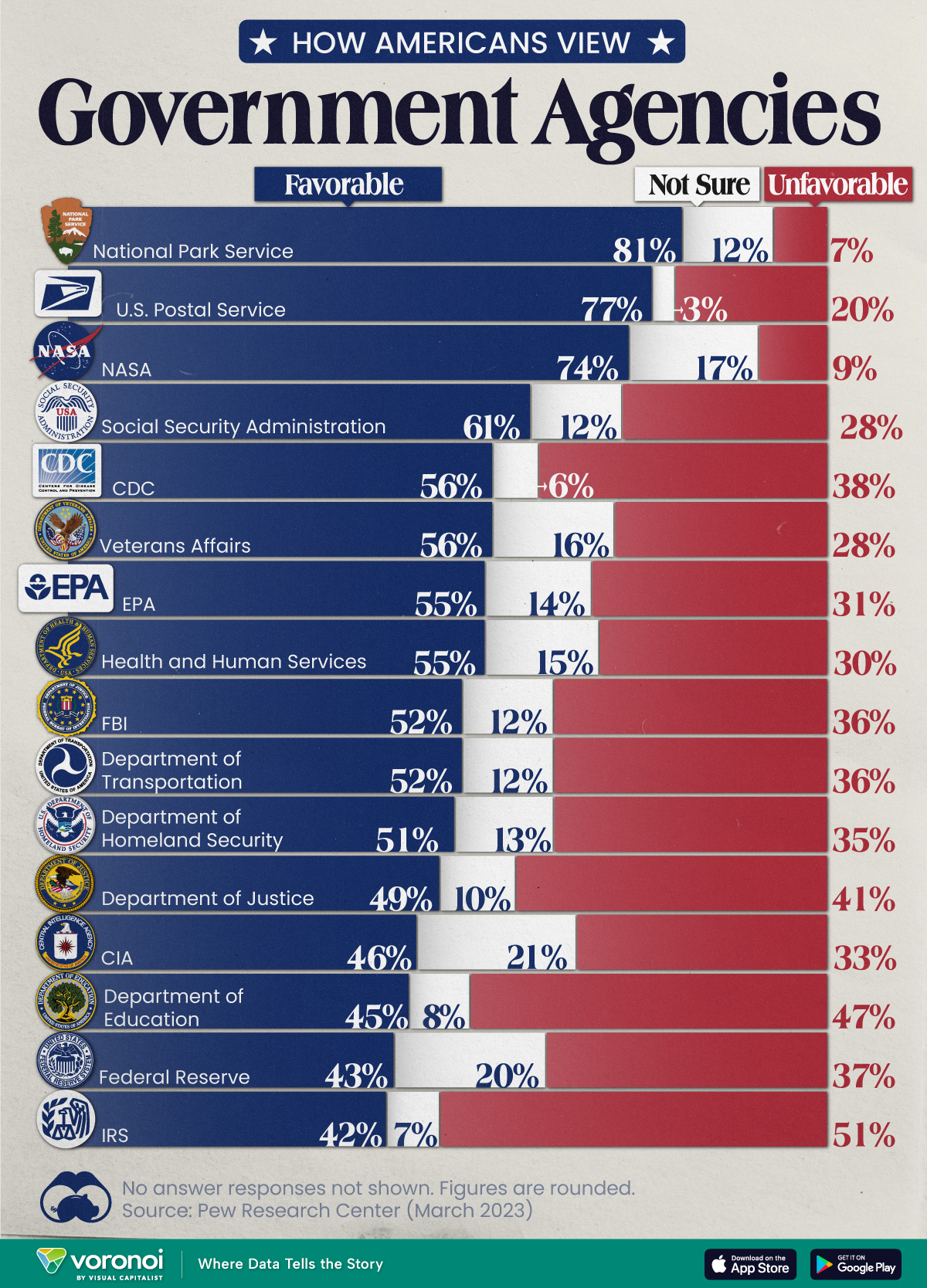Economy
Animated Chart: The S&P 500 in 2023 So Far
The S&P 500’s Performance in 2023 Q1
With one quarter of 2023 in the books, how has the S&P 500 performed so far?
The index had a tumultuous 2022, ending the year down 18%, its worst performance since 2008. But so far, despite dealing with tight monetary conditions and an unexpected banking crisis, the S&P 500 has promptly started to rebound.
The above animation from Jan Varsava shows the stock performance of each company on the S&P 500, categorized by sector.
Biggest Gainers on the S&P 500
The S&P 500 increased 7.5% during the first quarter of 2023. Though it was led by a few big outperformers, more than half of the stocks on the index closed above their end-of-December prices.
Here are the top 30 biggest gainers on the index from January 1 to March 31, 2023.
| Rank | Company | 3-Month Return |
|---|---|---|
| 1 | Nvidia | 90.1% |
| 2 | Meta (Facebook) | 76.1% |
| 3 | Tesla | 68.4% |
| 4 | Warner Bros. Discovery | 59.3% |
| 5 | Align Technology | 58.4% |
| 6 | AMD | 51.3% |
| 7 | Salesforce | 50.7% |
| 8 | West Pharmaceuticals | 47.3% |
| 9 | General Electric | 46.3% |
| 10 | Catalent | 46.0% |
| 11 | First Solar | 45.2% |
| 12 | Monolithic Power Systems | 41.8% |
| 13 | MarketAxess Holdings | 40.6% |
| 14 | GE Healthcare Tech | 40.5% |
| 15 | Arista Networks | 38.3% |
| 16 | ANSYS Inc. | 37.8% |
| 17 | Fortinet Inc. | 35.9% |
| 18 | Wynn Resorts | 35.7% |
| 19 | Paramount Global | 33.8% |
| 20 | FedEx Corp | 32.7% |
| 21 | MGM Resorts | 32.5% |
| 22 | Royal Caribbean Group | 32.1% |
| 23 | ON Semiconductor Corp | 32.0% |
| 24 | Booking Holdings | 31.6% |
| 25 | Cadence Design Systems | 30.8% |
| 26 | Skyworks Solutions | 30.2% |
| 27 | Pulte Group | 28.4% |
| 28 | Seagate Technology | 27.1% |
| 29 | Apple | 27.1% |
| 30 | Lam Research | 26.6% |
Nvidia shares gained the most of all the companies on the S&P 500 in Q1 2023, posting a staggering 90% return over three months.
As the world’s largest chipmaker by market cap, Nvidia gained from both strong earnings and semiconductor industry performance. It also benefited from the rising prevalence of artificial intelligence (AI) through software like ChatGPT.
Meanwhile, other tech giants Apple and Microsoft gained 27% and 21% respectively over the same time period.
Tech Leads Returns by Sector
The technology sector as a whole was the best performing sectoral index thanks to these big moves, up 21.7% at the end of March.
| Sector | 3-Month Return |
|---|---|
| Technology | 21.65% |
| Consumer Services | 21.27% |
| Consumer Discretionary | 16.60% |
| Materials | 4.29% |
| Industrials | 3.47% |
| Real Estate | 1.95% |
| Consumer Staples | 0.72% |
| Utilities | -3.24% |
| Health Care | -4.31% |
| Energy | -4.37% |
| Financials | -5.56% |
| S&P 500 | 7.5% |
Shares of other tech-adjacent companies like Meta (formerly Facebook) and Tesla—listed on the S&P 500 under the categories of communication services and consumer discretionary—also had a strong start to the year and lifted their respective sectors.
Meta in particular is up 76% in Q1 2023, continuing its rebound after falling to an eight-year low in November 2022 on the back of better-than-expected fourth quarter results and share buybacks.
Biggest Losers on the S&P 500
On the other side of the S&P 500, the financial sector was rocked by sudden collapses.
Signature Bank and Silicon Valley Financial Group shares lost the most ground in the first quarter, after both banks collapsed, shedding nearly all of their value in a matter of 30 days.
In fact, seven of the 10 worst performers on the index to start 2023 are banks or financial companies. The visualization shows the ripple effect on the market after the collapse of regional banks in March, and the ensuing rout driving the entire sector down 5.6% year-to-date.
Here are the top 30 biggest losers on the index from January 1 to March 31, 2023.
| Rank | Company | 3-Month Return |
|---|---|---|
| 1 | Signature Bank | -99.8% |
| 2 | Silicon Valley Financial Group | -99.6% |
| 3 | First Republic Bank | -88.5% |
| 4 | Lumen Technologies | -49.2% |
| 5 | Zions Bancorporation | -38.6% |
| 6 | Charles Schwab Corp | -36.9% |
| 7 | Comerica Incorporated | -33.9% |
| 8 | DISH Network | -33.5% |
| 9 | KeyCorp | -27.3% |
| 10 | Lincoln National Corp | -25.8% |
| 11 | Centene Corporation | -22.9% |
| 12 | Cigna Group | -22.5% |
| 13 | APA Corporation | -22.3% |
| 14 | Citizens Financial Group | -22.1% |
| 15 | Enphase Energy Inc. | -20.6% |
| 16 | Baxter International Inc. | -19.9% |
| 17 | Truist Financial Corporation | -19.9% |
| 18 | American International Group | -19.8% |
| 19 | CVS Health Corporation | -19.7% |
| 20 | Pfizer | -19.6% |
| 21 | Gen Digital | -19.5% |
| 22 | MetLife | -19.4% |
| 23 | Huntington Bancshares | -19.4% |
| 24 | Fidelity National | -19.3% |
| 25 | Halliburton Company | -19.2% |
| 26 | Molina Healthcare | -19.0% |
| 27 | PNC Financial Services | -18.8% |
| 28 | Boston Properties | -18.4% |
| 29 | Fifth Third Bancorp | -17.8% |
| 30 | Allstate Corporation | -17.7% |
Despite the tight monetary landscape, traditionally defensive sectors like energy, consumer staples, and healthcare also underperformed the broader index. This is a reversal from market trends seen in 2022.
Investment Trends to Watch for in 2023
Experts predict a pause in U.S. interest rate hikes “sometime in 2023” but it’s unclear when (or at what level) the pause will take place given persistent inflation in the economy.
However, if interest rates level off in 2023, it could be a key momentum maker for the S&P 500. As Barron’s points out, the index tends to rise after hikes are paused.
Meanwhile, the current tumult in the financial sector is fanning the flames of recessionary fears. How effectively regulators manage the crisis might be the story of the year.
Finally, as we have seen in 2023 so far, investor interest in AI has sent tech stocks soaring. Is this a quick fad, or an overarching trend for the year?

This article was published as a part of Visual Capitalist's Creator Program, which features data-driven visuals from some of our favorite Creators around the world.
Public Opinion
Charted: How Americans Feel About Federal Government Agencies
Fourteen of 16 federal government agencies garnered more favorable responses than unfavorable ones. But what were the outliers?

Chart: How Americans Rate 16 Federal Government Agencies
This was originally posted on our Voronoi app. Download the app for free on iOS or Android and discover incredible data-driven charts from a variety of trusted sources.
Come election time, America won’t hesitate to show its approval or disapproval of the country’s elected political representatives. That said, feelings about the federal bureaucracy and its associated agencies are a little harder to gauge.
We chart the results from an opinion poll conducted by Pew Research Center between March 13-19, 2023. In it, 10,701 adults—a representative of the U.S. adult population—were asked whether they felt favorably or unfavorably towards 16 different federal government agencies.
Americans Love the Park Service, Are Divided Over the IRS
Broadly speaking, 14 of the 16 federal government agencies garnered more favorable responses than unfavorable ones.
Of them, the Parks Service, Postal Service, and NASA all had the approval of more than 70% of the respondents.
| Agency | Favorable | Unfavorable | Not sure |
|---|---|---|---|
| 🏞️ National Park Service | 81% | 7% | 12% |
| 📮 U.S. Postal Service | 77% | 20% | 3% |
| 🚀 NASA | 74% | 9% | 17% |
| 💼 Social Security Administration | 61% | 28% | 12% |
| 🔬 CDC | 56% | 38% | 6% |
| 🎖️ Veterans Affairs | 56% | 28% | 16% |
| 🌿 EPA | 55% | 31% | 14% |
| 💉 Health & Human Services | 55% | 30% | 15% |
| 🕵️ FBI | 52% | 36% | 12% |
| 🚗 Department of Transportation | 52% | 36% | 12% |
| 🛡️ Department of Homeland Security | 51% | 35% | 13% |
| ⚖️ Department of Justice | 49% | 41% | 10% |
| 🕵️♂️ CIA | 46% | 33% | 21% |
| 📚 Department of Education | 45% | 47% | 8% |
| 💰 Federal Reserve | 43% | 37% | 20% |
| 💼 IRS | 42% | 51% | 7% |
Note: Figures are rounded. No answer responses are not shown.
Only the Department of Education and the IRS earned more unfavorable responses, and between them, only the IRS had a majority (51%) of unfavorable responses.
There are some caveats to remember with this data. Firstly, tax collection is a less-friendly activity than say, maintaining picturesque parks. Secondly, the survey was conducted a month before taxes were typically due, a peak time for experiencing filing woes.
Nevertheless, the IRS has come under fire in recent years. As per a New York Times article in 2019, eight years of budget cuts have stymied the agency’s ability to scrutinize tax filings from wealthier and more sophisticated filers.
At the same time poorer Americans are facing increasing audits on wage subsidies available to low income workers. According to a Transactional Records Access Clearinghouse report, this subset of filers was audited five-and-a-half more times the average American.
-

 Healthcare5 days ago
Healthcare5 days agoLife Expectancy by Region (1950-2050F)
-

 Economy2 weeks ago
Economy2 weeks agoRanked: The Top 20 Countries in Debt to China
-

 Politics2 weeks ago
Politics2 weeks agoCharted: Trust in Government Institutions by G7 Countries
-

 Energy2 weeks ago
Energy2 weeks agoMapped: The Age of Energy Projects in Interconnection Queues, by State
-

 Mining2 weeks ago
Mining2 weeks agoVisualizing Global Gold Production in 2023
-

 Markets1 week ago
Markets1 week agoVisualized: Interest Rate Forecasts for Advanced Economies
-

 Economy1 week ago
Economy1 week agoThe Most Valuable Companies in Major EU Economies
-

 Markets1 week ago
Markets1 week agoThe World’s Fastest Growing Emerging Markets (2024-2029 Forecast)













